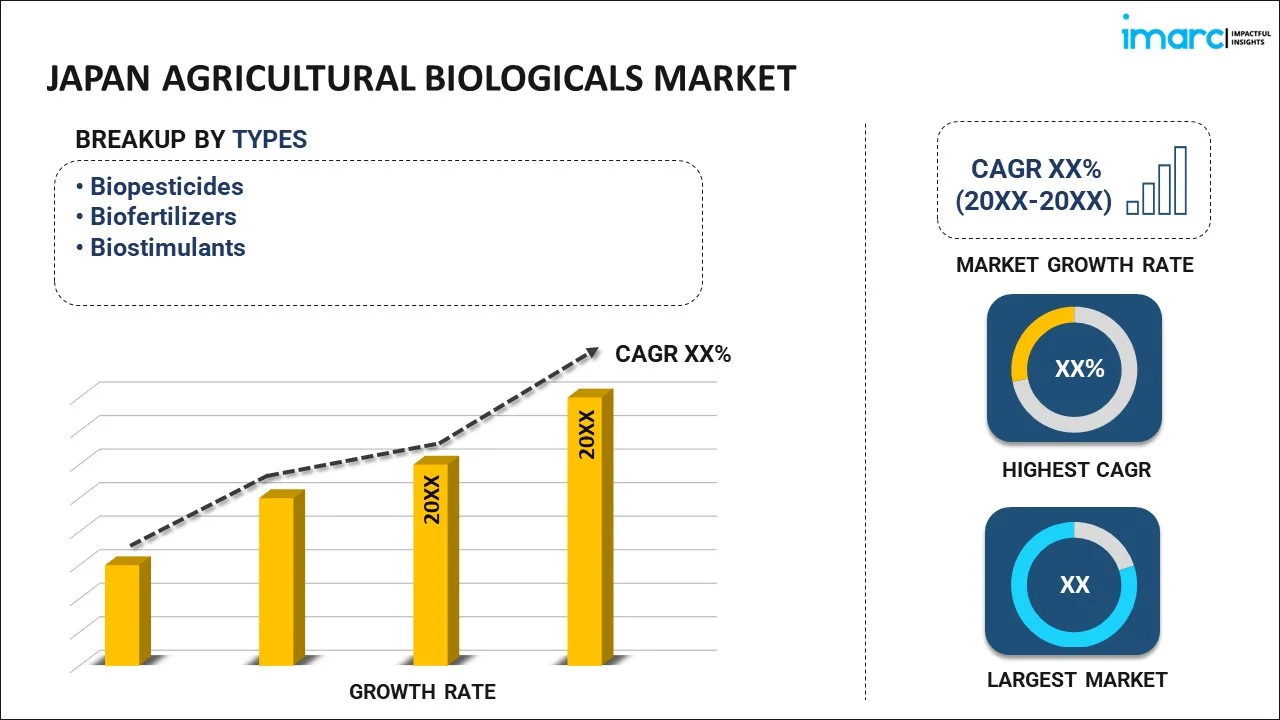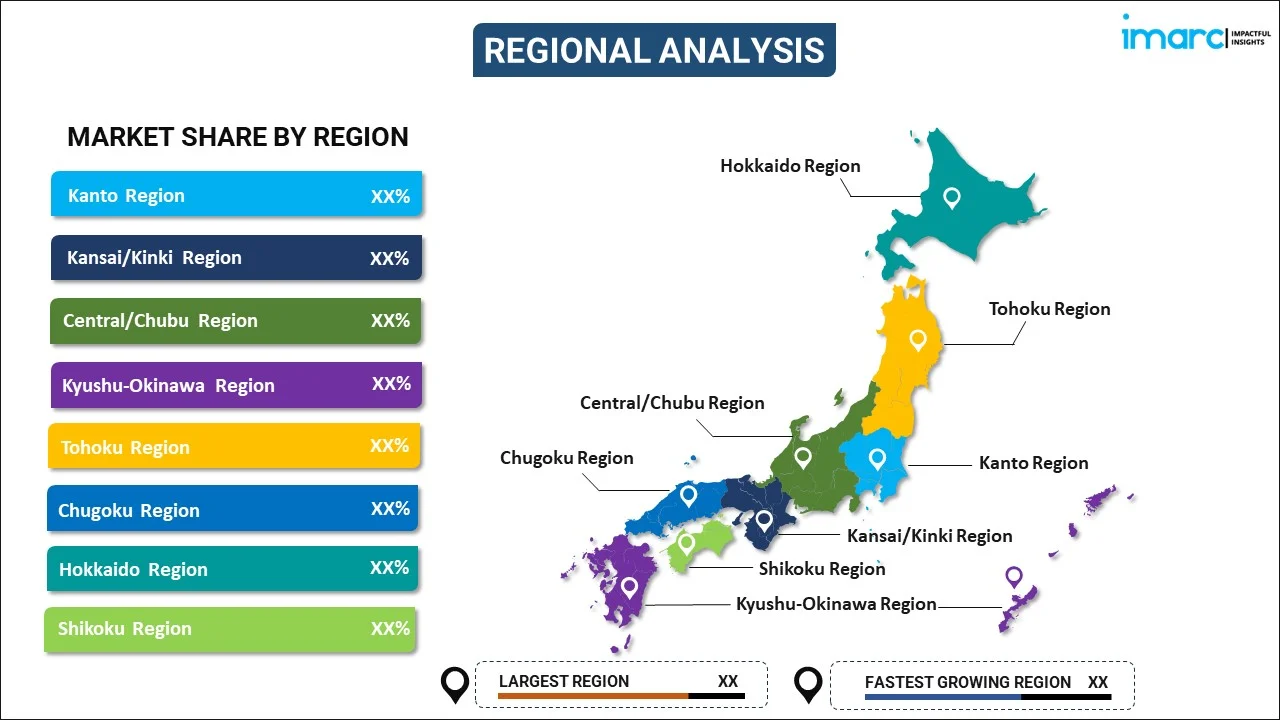
Japan Agricultural Biologicals Market Report by Type (Biopesticides, Biofertilizers, Biostimulants), Source (Microbials, Macrobials, Biochemicals, and Others), Mode of Application (Foliar Spray, Soil Treatment, Seed Treatment, Post-Harvest), Application (Cereals and Grains, Oilseed and Pulses, Fruits and Vegetables, Turf and Ornamentals, and Others), and Region 2025-2033
Market Overview:
Japan agricultural biologicals market size reached USD 402.5 Million in 2024. Looking forward, IMARC Group expects the market to reach USD 1,393.9 Million by 2033, exhibiting a growth rate (CAGR) of 13.5% during 2025-2033. The increasing popularity of organic and sustainably produced food products, which has created a demand pull for crops grown using biologicals, is primarily driving the market.
|
Report Attribute
|
Key Statistics
|
|---|---|
|
Base Year
|
2024
|
|
Forecast Years
|
2025-2033
|
|
Historical Years
|
2019-2024
|
|
Market Size in 2024
|
USD 402.5 Million |
|
Market Forecast in 2033
|
USD 1,393.9 Million |
| Market Growth Rate 2025-2033 | 13.5% |
Agricultural biologicals are a category of products and technologies used in modern agriculture to enhance crop productivity and sustainability. These biologicals harness the power of living organisms or their derivatives to improve plant health, protect against pests and diseases, and promote overall crop vitality. They include beneficial microorganisms like bacteria and fungi, as well as natural compounds and extracts derived from plants and animals. One key aspect of agricultural biologicals is their eco-friendly nature, as they often reduce the need for chemical pesticides and synthetic fertilizers. They can enhance soil health, increase nutrient uptake, and stimulate plant growth while minimizing environmental harm. Additionally, agricultural biologicals can be integrated into integrated pest management (IPM) programs, offering a more holistic approach to farming. Farmers are increasingly adopting agricultural biologicals to meet the growing demand for sustainable and environmentally friendly agricultural practices. These products contribute to higher yields, improved crop quality, and reduced chemical inputs, making them a valuable tool in modern agriculture's pursuit of greater efficiency and environmental responsibility.
Japan Agricultural Biologicals Market Trends:
The agricultural biologicals market in Japan is experiencing robust growth owing to several key drivers. Firstly, there is a growing regional awareness of the environmental impact of conventional agricultural practices, such as the excessive use of chemical pesticides and fertilizers. Consequently, farmers are increasingly seeking sustainable and eco-friendly alternatives, which has led to a surge in demand for biological solutions. Moreover, government regulations and policies aimed at reducing the usage of chemical inputs in agriculture have further propelled the adoption of agricultural Biologicals. Additionally, the rising need for higher crop yields to feed the ever-expanding regional population is a significant driver. Agricultural Biologicals offer a way to enhance crop productivity while minimizing the adverse effects on soil and ecosystems, making them an attractive choice for modern agriculture. Furthermore, advancements in biotechnology and genetic engineering, which have paved the way for the development of innovative biologicals with improved efficacy and specificity, are expected to drive the agricultural biologicals market in Japan during the forecast period.
Japan Agricultural Biologicals Market Segmentation:
IMARC Group provides an analysis of the key trends in each segment of the market, along with forecasts at the country level for 2025-2033. Our report has categorized the market based on type, source, mode of application, and application.
Type Insights:

- Biopesticides
- Biofertilizers
- Biostimulants
The report has provided a detailed breakup and analysis of the market based on the type. This includes biopesticides, biofertilizers, and biostimulants.
Source Insights:
- Microbials
- Macrobials
- Biochemicals
- Others
A detailed breakup and analysis of the market based on the source have also been provided in the report. This includes microbials, macrobials, biochemicals, and others.
Mode of Application Insights:
- Foliar Spray
- Soil Treatment
- Seed Treatment
- Post-Harvest
The report has provided a detailed breakup and analysis of the market based on the mode of application. This includes foliar spray, soil treatment, seed treatment, and post-harvest.
Application Insights:
- Cereals and Grains
- Oilseed and Pulses
- Fruits and Vegetables
- Turf and Ornamentals
- Others
A detailed breakup and analysis of the market based on the application have also been provided in the report. This includes cereals and grains, oilseed and pulses, fruits and vegetables, turf and ornamentals, and others.
Regional Insights:

- Kanto Region
- Kansai/Kinki Region
- Central/ Chubu Region
- Kyushu-Okinawa Region
- Tohoku Region
- Chugoku Region
- Hokkaido Region
- Shikoku Region
The report has also provided a comprehensive analysis of all the major regional markets, which include Kanto Region, Kansai/Kinki Region, Central/ Chubu Region, Kyushu-Okinawa Region, Tohoku Region, Chugoku Region, Hokkaido Region, and Shikoku Region.
Competitive Landscape:
The market research report has also provided a comprehensive analysis of the competitive landscape. Competitive analysis such as market structure, key player positioning, top winning strategies, competitive dashboard, and company evaluation quadrant has been covered in the report. Also, detailed profiles of all major companies have been provided.
Japan Agricultural Biologicals Market Report Coverage:
| Report Features | Details |
|---|---|
| Base Year of the Analysis | 2024 |
| Historical Period | 2019-2024 |
| Forecast Period | 2025-2033 |
| Units | Million USD |
| Scope of the Report | Exploration of Historical and Forecast Trends, Industry Catalysts and Challenges, Segment-Wise Historical and Predictive Market Assessment:
|
| Types Covered | Biopesticides, Biofertilizers, Biostimulants |
| Sources Covered | Microbials, Macrobials, Biochemicals, Others |
| Mode of Applications Covered | Foliar Spray, Soil Treatment, Seed Treatment, Post-Harvest |
| Applications Covered | Cereals and Grains, Oilseed and Pulses, Fruits and Vegetables, Turf and Ornamentals, Others |
| Regions Covered | Kanto Region, Kansai/Kinki Region, Central/ Chubu Region, Kyushu-Okinawa Region, Tohoku Region, Chugoku Region, Hokkaido Region, Shikoku Region |
| Customization Scope | 10% Free Customization |
| Post-Sale Analyst Support | 10-12 Weeks |
| Delivery Format | PDF and Excel through Email (We can also provide the editable version of the report in PPT/Word format on special request) |
Key Questions Answered in This Report:
- How has the Japan agricultural biologicals market performed so far and how will it perform in the coming years?
- What has been the impact of COVID-19 on the Japan agricultural biologicals market?
- What is the breakup of the Japan agricultural biologicals market on the basis of type?
- What is the breakup of the Japan agricultural biologicals market on the basis of source?
- What is the breakup of the Japan agricultural biologicals market on the basis of mode of application?
- What is the breakup of the Japan agricultural biologicals market on the basis of application?
- What are the various stages in the value chain of the Japan agricultural biologicals market?
- What are the key driving factors and challenges in the Japan agricultural biologicals?
- What is the structure of the Japan agricultural biologicals market and who are the key players?
- What is the degree of competition in the Japan agricultural biologicals market?
Key Benefits for Stakeholders:
- IMARC’s industry report offers a comprehensive quantitative analysis of various market segments, historical and current market trends, market forecasts, and dynamics of the Japan agricultural biologicals market from 2019-2033.
- The research report provides the latest information on the market drivers, challenges, and opportunities in the Japan agricultural biologicals market.
- Porter's five forces analysis assist stakeholders in assessing the impact of new entrants, competitive rivalry, supplier power, buyer power, and the threat of substitution. It helps stakeholders to analyze the level of competition within the Japan agricultural biologicals industry and its attractiveness.
- Competitive landscape allows stakeholders to understand their competitive environment and provides an insight into the current positions of key players in the market.
Need more help?
- Speak to our experienced analysts for insights on the current market scenarios.
- Include additional segments and countries to customize the report as per your requirement.
- Gain an unparalleled competitive advantage in your domain by understanding how to utilize the report and positively impacting your operations and revenue.
- For further assistance, please connect with our analysts.
 Inquire Before Buying
Inquire Before Buying
 Speak to an Analyst
Speak to an Analyst
 Request Brochure
Request Brochure
 Request Customization
Request Customization




.webp)




.webp)












